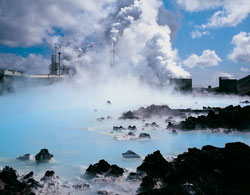Getting to the bottom of Aerosol Optical Depth
Aerosols in the atmosphere come from both natural (e.g. volcanos, forest fires, etc.) and anthropogenic (e.g. industry, automobiles, etc.) sources. They can influence climate change, air pollution and a number of other important phenomena. Meteorologists measure the Aerosol Optical Depth (AOD) in order to determine the amount of aerosol suspended in the atmosphere. AOD can be measured from satellites, aircraft and ground-based equipment. The organisations involved in the CREATE project sought to combine several disjointed sources of AOD data into one coherent database. Data provided from the ATSR-2 (Along Track Scanning Radiometer) was supplemented with sun photometer data from the AERONET project. Special algorithms were developed at TNO in the Netherlands to remove data affected by cloudy sky conditions. The result of the efforts of the CREATE participants is a database of AOD at 0.55 and 0.67 micrometers for the year 2000. The area covered corresponds to 20W to 40E and 20N to 80N while spatial resolution is 10 by 10 kilometers. Monthly values provide an indication of the variation of AOD in time but cannot be considered true average values because of the inherent gaps in data collection by the satellite. The AOD database is available online at: http://macehead.nuigalway.ie/create/(opens in new window). Complementary applications developed during the project allow users to transform the AOD data into other grid formats. Other products are also available online, such as maps from a single satellite overpass that are applicable for modelling exercises. The CREATE consortium actively collaborated with other project consortiums, namely from the DAEDALUS and TEMIS projects, to realise the greatest benefit from the AOD database. They continue to seek out new users from the scientific community looking to exploit the data contained in the database for new purposes.







